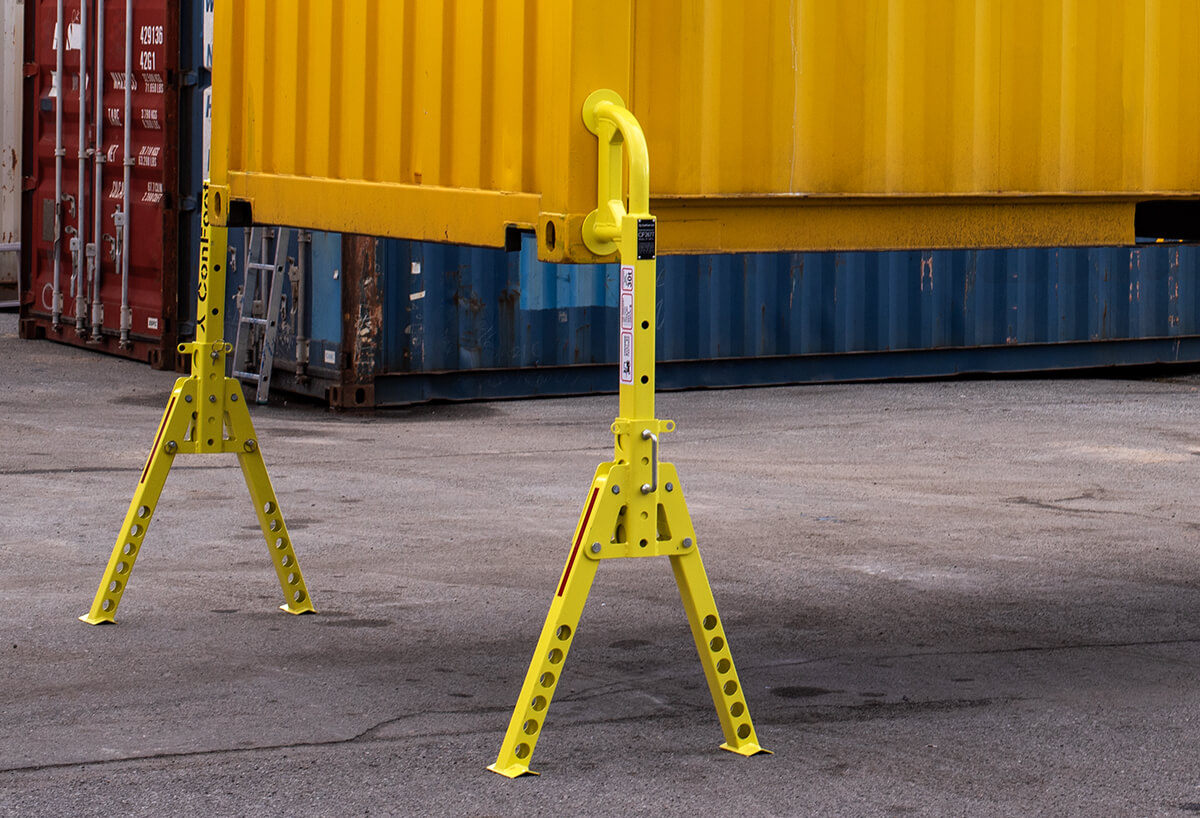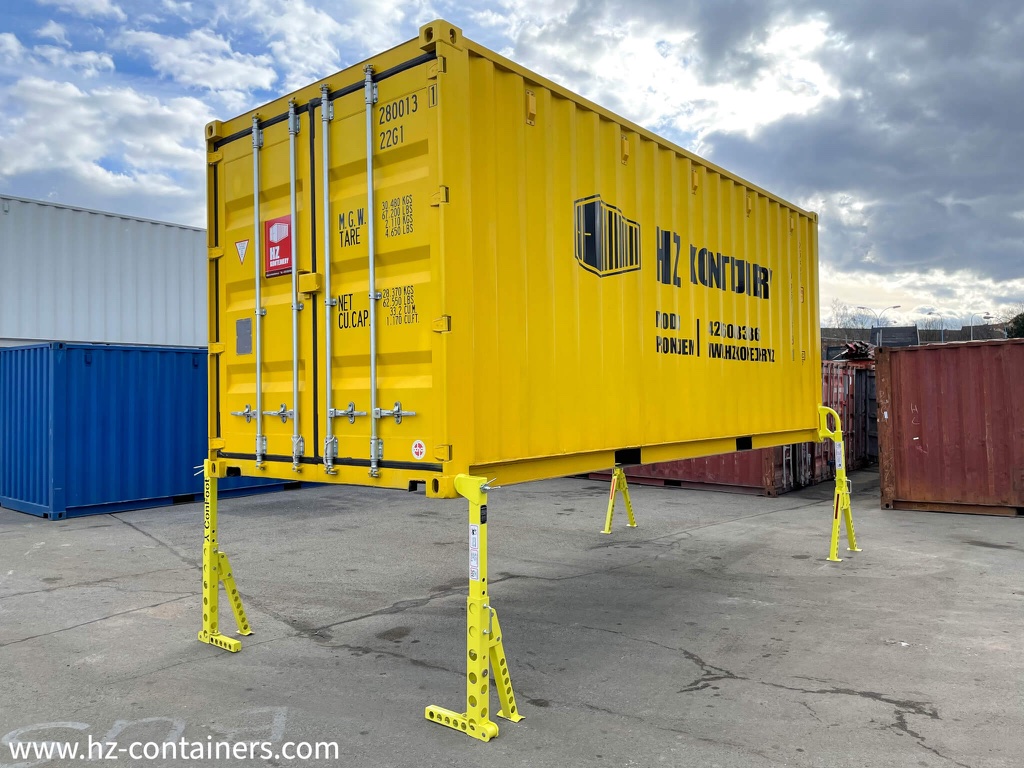Definition and Purpose of Shipping Container Legs
Shipping container legs are tools that improve logistics operations by making container handling more efficient. They allow trucks to disconnect from shipping containers during loading or unloading, enabling drivers to move on to their next task without delays. By reducing idle time, these tools increase the productivity of logistics fleets.
Design and Compatibility
Shipping container legs are designed to attach to the underside of standard shipping containers. They work with most container sizes, making them suitable for a variety of logistics operations. The system includes retractable legs that can be extended to support the container when it is separated from the truck. This simple design makes it easy for drivers to use and highly effective in the field.
Step-by-Step Functionality

1. Attaching the Legs: Before arriving at the unloading location, the driver secures the container legs to specific points on the container. The legs are extended to stabilize the container.
2. Detaching the Container: At the drop-off site, the driver detaches the container from the truck. The container remains stable, supported by the legs, and the truck can leave immediately without waiting for the loading or unloading to finish.
3. Efficient Reattachment: After the container is emptied or loaded, the truck returns to the site. The driver backs the truck under the container, retracts the legs, and reattaches the container to the truck.
This process saves time, simplifies operations, and helps drivers focus on their next tasks. The easy-to-use design of shipping container legs makes them a valuable tool in logistics, improving truck efficiency and optimizing the supply chain.
Key Benefits for Truck Drivers and Logistics
Enhanced Time Efficiency for Truck Drivers
Shipping container legs help reduce the time spent on loading and unloading processes. In traditional logistics, truck drivers often wait until containers are manually unloaded at their destinations, leading to long idle periods. With shipping container legs, drivers can quickly attach the extendable legs to the container, leave it at the destination, and move on to their next task. This system prevents drivers from being stuck in one place too long, enabling them to complete more deliveries in less time.
By cutting down on wait times, container legs improve delivery schedules and make truck drivers more efficient. This process reduces delays and helps drivers make the most of their workday.
Optimized Fuel Consumption and Cost Savings
Reducing idle time means using less fuel. When trucks idle, they consume about 0.8 gallons of fuel per hour, unnecessarily increasing operation costs. Shipping container legs allow drivers to drop off containers and continue driving, reducing idle hours and saving fuel. This approach also minimizes vehicle wear and tear, lowering maintenance costs and extending truck lifespan.
For logistics companies, these savings add up over time, making freight transportation more economical. By using fuel more efficiently and minimizing downtime, container legs offer a cost-effective solution for today’s logistics challenges.
Improved Delivery Schedules and Customer Satisfaction
Using container legs speeds up delivery processes and improves precision. Quicker drop-off and pick-up times help businesses adhere to tight schedules and deliver goods on time. This is especially crucial in industries like e-commerce and retail, where meeting delivery deadlines is essential for customer satisfaction.
Reliable delivery schedules build trust between logistics companies and their clients. When businesses consistently meet expectations, they strengthen client relationships and open doors to long-term growth. Container legs help ensure that supply chains function smoothly and efficiently.
Reduced Driver Fatigue and Enhanced Safety
Shipping container legs improve working conditions for truck drivers by reducing long waiting periods. Spending less time in one place means drivers experience less physical strain and discomfort. Maintaining a steady workflow also helps reduce driver fatigue, which contributes to safer driving habits.
Fewer delays and lower stress levels promote safety for everyone on the road. Drivers are less likely to feel rushed or overly tired, decreasing the risk of accidents and creating a safer environment for all road users.
Streamlined Logistics Operations
For logistics companies, shipping container legs simplify the overall supply chain process. These tools reduce bottlenecks and enhance coordination across various modes of transportation. Whether a company operates in retail, manufacturing, or e-commerce, container legs provide a scalable solution suited to modern logistics.
By incorporating container legs into their systems, businesses can optimize every aspect of freight management—from handling containers to delivering goods. This efficiency underscores the significant impact container legs have on improving logistics operations.
Real-World Applications and Industry Use Cases
Revolutionizing Logistics in Retail and E-Commerce
The retail and e-commerce industries depend on quick and efficient delivery systems to meet customer expectations. Shipping container legs have become essential in these areas by reducing delays during loading and unloading. With container legs, trucks can drop off containers and promptly move on to their next task without waiting for manual unloading. This reduces downtime and helps businesses stick to tight delivery schedules, ensuring a steady inventory flow and allowing retailers to meet competitive shipping deadlines.
For e-commerce companies, where speed is paramount, shipping container legs streamline last-mile delivery. By maximizing truck usage and minimizing idle time, companies can deliver products faster, boosting customer satisfaction. This system also enables e-commerce companies to manage the surge in shipments during busy seasons more effectively.
Enhancing Efficiency in Manufacturing Supply Chains
In the manufacturing sector, shipping container legs improve supply chain coordination by streamlining the transport of raw materials and finished products. Factories often operate on strict timelines, and delays in goods delivery can disrupt production. With container legs, trucks can deliver materials directly to factories and then move on to the next job, ensuring uninterrupted supply chains.
This system reduces the time trucks and workers spend idle, lowering costs and increasing overall productivity. Industries that handle frequent shipments, such as automotive or electronics manufacturing, greatly benefit from this technology.
Accelerating Global Trade for Freight Companies
In global trade, shipping container legs enable smooth transitions between transportation modes like ships, trucks, and trains. Freight companies rely on container legs to minimize delays at ports and intermodal terminals where time is of the essence. Once a truck delivers a container, it can quickly take on another task while the container is securely unloaded.
This process is especially valuable for businesses dealing with perishable goods or time-sensitive shipments, as it speeds up transport and reduces the risks of spoilage or missed deadlines.
Case Study: A Logistics Firm’s Success with Container Legs
A mid-sized logistics company specializing in food distribution adopted shipping container legs to enhance fleet operations. By implementing this system, the company reduced unloading times by 40%, allowing trucks to complete more deliveries each day. This improvement resulted in significant savings on fuel and labor costs while ensuring customers received their orders on time. This case study demonstrates the practical benefits and enhanced operational efficiency provided by container legs.
Shipping container legs have proven effective across various industries. They simplify logistics, reduce delays, and boost overall productivity. Their versatility and practicality make them an essential tool for businesses aiming to optimize their supply chains and improve delivery performance.




